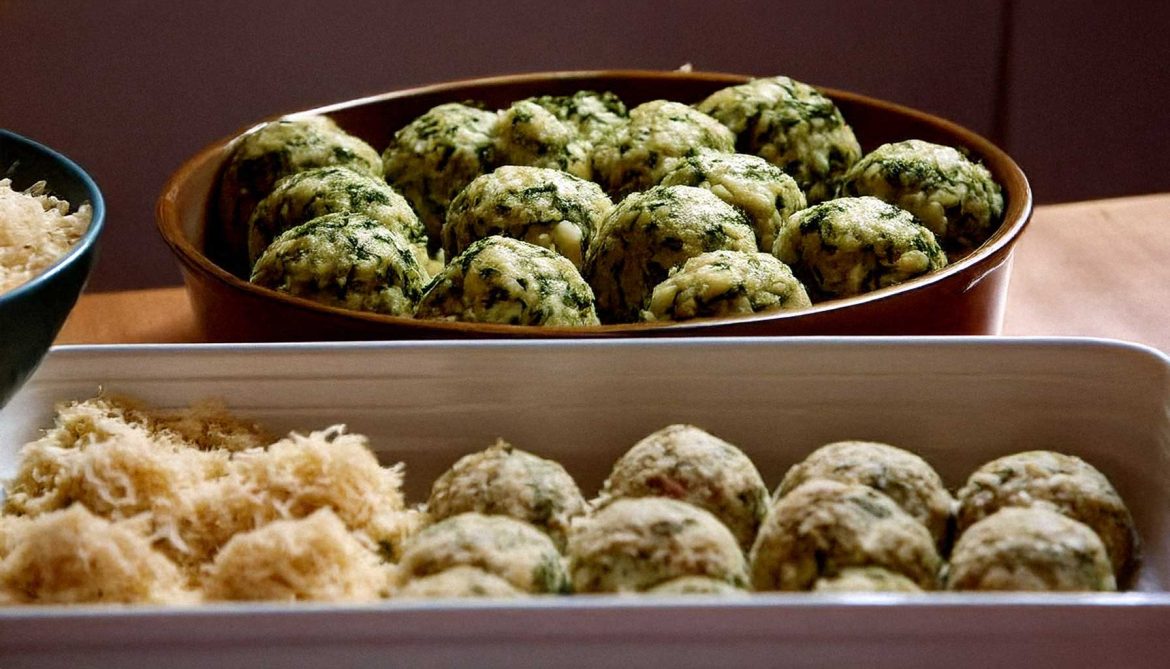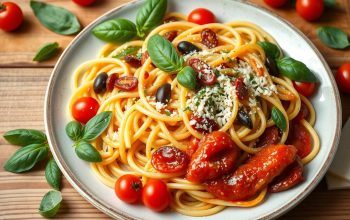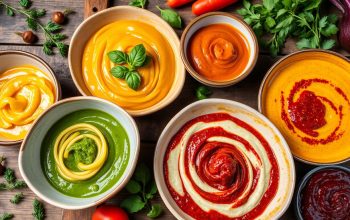I love exploring different foods from around the world. Austria’s rich food history really caught my eye. Their dumplings, or “knödel,” are a big part of Austrian meals. These side dishes have been enjoyed for centuries, showing off the country’s creativity and regional flavors.
In this article, we’ll dive into Austrian dumplings. We’ll look at their history, traditional recipes, and their role in Austrian food. You’ll learn about favorites like Semmelknödel, Zwiebelknödel, and Nockerl. These dishes highlight the variety and richness of Austrian cuisine.
Key Takeaways
- Austrian dumplings, or “knödel,” are a diverse and integral part of the country’s culinary heritage.
- Dumplings come in a variety of styles, from bread-based to potato-based, and can be savory or sweet.
- Dumplings hold significant cultural significance in Austria, often associated with special occasions and traditional dishes.
- Mastering the art of making authentic Austrian dumplings requires attention to detail and traditional techniques.
- Dumplings can be enjoyed as a side dish or as the main attraction in various Austrian cuisine specialties.
Understanding the Rich Heritage of Austrian Dumplings
I love exploring the history and cultural value of traditional Austrian dishes. The Austrian dumplings, or knödel, are especially dear to the Austrian people. They are simple yet delicious.
From Medieval Times to Modern Austrian Tables
Austrian dumplings have a long history, dating back to the Middle Ages. They were a main food for common folk. Over time, these dumplings changed, influenced by different regions in Austria.
Today, you can find many types of knödel. From the big Semmelknödel in the Alps to the light Schiacherkrapfen in Styria. Each shows Austria’s rich food heritage.
Regional Variations Across Austria
- In the Tyrolean Alps, Spinatknödel (spinach dumplings) are loved for their fresh taste.
- The Zwiebelknödel (onion dumplings) of Vorarlberg are famous for their sweet onion flavor.
- Lower Austria’s Serviettenknödel (napkin dumplings) show the creativity of local cooks.
Cultural Significance in Austrian Cuisine
Knödel are more than tasty food; they are a big part of Austrian culture. They are not just side dishes but a key part of Austrian food identity. They bring people together, whether it’s for special occasions or simple family meals.
“The knödel is more than just a food; it’s a cultural symbol that unites Austrians across the country.”
Essential Ingredients for Authentic Austrian Dumplings
Creating the perfect Austrian dumplings starts with the right ingredients. From bread to herbs, each part is crucial. They give the dumplings their unique taste and texture that people love.
The bread is at the core of Austrian dumplings. A light, airy white bread or brioche is best. It should be stale or slightly dry to soak up the liquid well. Eggs are also key, as they help the mixture stick together and add a creamy feel.
Dairy like milk and butter makes the dough creamy. Herbs like parsley, chives, and nutmeg add flavor. These ingredients make each bite of an Austrian dumpling a mix of textures and tastes.
- Bread: Light, airy white bread or brioche, stale or slightly dried
- Eggs: Bind the mixture and lend a rich, creamy texture
- Milk and butter: Provide a luxurious creaminess
- Herbs: Parsley, chives, nutmeg, and other aromatic seasonings
By balancing these ingredients, anyone can make delicious Austrian dumplings. They capture the essence of this cherished culinary tradition.
“The secret to the perfect Austrian dumpling lies in the quality and balance of its ingredients. Each component must work in harmony to create a truly exceptional dish.”
Traditional Semmelknödel: The Classic Bread Dumpling
Semmelknödel, the iconic Austrian bread dumplings, have been a staple on tables across the country for centuries. These fluffy, savory morsels are a beloved side dish that perfectly complement a wide range of traditional Austrian main courses. Crafting the perfect semmelknödel requires a keen eye for ingredient selection and a touch of culinary finesse.
Choosing the Right Bread
The foundation of a great semmelknödel lies in the bread used. Traditionally, Austrian bakers select a slightly stale, dense white bread, such as a Kaisersemmel or a rustic Landbrot. The bread’s firm texture and ability to soak up flavors are crucial for achieving the desired dumpling consistency.
Step-by-Step Preparation Guide
- Cube the bread and allow it to dry out slightly, either by leaving it out overnight or briefly toasting it.
- Combine the bread cubes with milk, eggs, and a blend of aromatic spices, such as nutmeg, parsley, and chives.
- Gently form the mixture into round dumplings, being careful not to overwork the dough.
- Carefully lower the dumplings into a pot of simmering broth or water, and cook until they are tender and cooked through.
Common Mistakes to Avoid
- Using too much or too little liquid, which can result in dense or crumbly dumplings.
- Overcooking the dumplings, leading to a gummy or waterlogged texture.
- Neglecting to properly dry the bread cubes, resulting in a heavy, doughy dumpling.
Mastering the art of semmelknödel takes practice, but with the right techniques and a keen eye for detail, you can create these beloved Austrian bread dumplings. They will delight your taste buds and transport you to the heart of Austrian cuisine.
Spinatknödel: Green Gems of Tyrolean Cuisine
In the beautiful region of Tyrol, nestled in the Austrian Alps, a special dish is found. The spinatknödel, filled with spinach, is a favorite in Tyrolean food. It shows the area’s rich food history.
To make real spinatknödel, you need fresh spinach. It’s chopped and mixed with breadcrumbs, eggs, and spices. Then, the mix is shaped into dumplings and cooked until they’re just right.
Spinatknödel are very versatile. They can be a main dish or added to stews or meat platters. Their soft inside and crunchy outside make them a joy to eat.
Spinatknödel are more than just food in Tyrol. They’re a big part of the region’s culture. They’re eaten at festivals, showing the area’s love for good food. Making and eating them together brings people closer, keeping Tyrolean food traditions alive.
If you’re in Tyrol or want to try its flavors at home, don’t miss the spinatknödel. These green dumplings are a true taste of Tyrolean food, blending culture and deliciousness.
| Ingredient | Amount |
|---|---|
| Fresh spinach | 1 lb (450g) |
| Breadcrumbs | 1 cup (120g) |
| Eggs | 2 |
| Onion | 1 small, finely chopped |
| Nutmeg | 1/4 tsp |
| Salt and pepper | to taste |
The Art of Making Perfect Austrian Dumplings
Making delicious Austrian knödel (dumplings) needs attention to detail and a deep understanding of Austrian dumpling techniques. Temperature, texture, and consistency are all key to getting it right.
Temperature Control Techniques
Keeping the water at the right temperature is crucial. It should simmer, not boil, to cook the dumplings evenly. This helps them stay tender and fluffy.
Overcooking makes them dense and heavy. Undercooking leaves them raw and doughy.
Texture and Consistency Tips
- Choose the right bread for Semmelknödel (bread dumplings). A sturdy, day-old loaf is best to soak up the broth without getting too mushy.
- Fold the ingredients gently, avoiding over-mixing. This prevents a dense, gummy texture.
- Watch the bread-to-liquid ratio. Too much liquid can make the knödel too soft and delicate.
Testing for Doneness
Knowing when the knödel are cooked just right is an art. A simple toothpick test works well. Stick a toothpick into the center of a dumpling. If it comes out clean, they’re done.
Overcooked dumplings are dense and heavy. Undercooked ones are raw and doughy.
Mastering these techniques can take your knödel making to the next level. Every bite will be a joyous celebration of Austrian culinary tradition.
Sweet Germknödel: A Dessert Dumpling Delight
In Austrian cuisine, germknödel stands out as a favorite for those who love sweets. These dumplings are a treasure, mixing old-world skill with a sweet taste that excites your senses.
The secret to germknödel’s charm is its filling. Inside each dumpling, you’ll find plum preserve or sweet poppy seed paste. This is wrapped in a soft, fluffy dough. The mix of the soft dough and the rich filling is divine.
Making these Austrian treats needs a careful hand. The dough is kneaded just right, not too thick, not too thin. The filling is made with care, balancing sweetness and texture perfectly.
Germknödel are best served warm, with vanilla sauce or powdered sugar on top. Some add roasted breadcrumbs or sour cream for more flavor.
Germknödel are a symbol of Austria’s rich food culture. They’re a must-try for anyone wanting to dive into Austrian food.
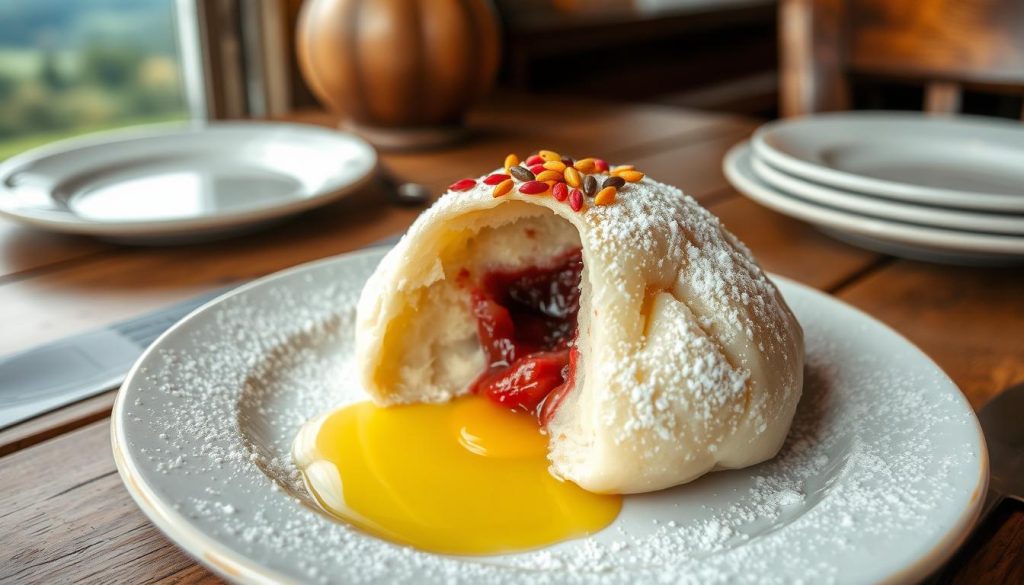
“Germknödel are the perfect balance of comfort and sophistication – a delightful Austrian tradition that never fails to delight the senses.”
So, if you’re looking for a sweet, indulgent treat, try germknödel. It’s a taste of Austrian dessert paradise.
Zwiebelknödel: Savory Onion Dumplings Explained
Zwiebelknödel, the beloved Austrian onion dumplings, are a true culinary delight. They deserve their place among the nation’s iconic side dish classics. These savory spheres showcase the magic that can happen when perfectly caramelized onions are masterfully combined with a few simple ingredients.
Caramelizing Onions Perfectly
The key to exceptional zwiebelknödel lies in the art of caramelizing the onions. Slow-cooking the onions over low heat, allowing their natural sugars to gently caramelize, is the secret. This process takes patience and attentiveness, but the result is well worth the effort.
Binding Techniques
Once the onions have reached their perfect caramelized state, the next step is to bind them together into cohesive dumplings. This is where the interplay of ingredients like bread, eggs, and seasonings comes into play. The right balance and technique are crucial for creating zwiebelknödel with a tender, yet sturdy texture that holds its shape while delivering a harmonious blend of savory flavors.
Mastering the art of onion dumplings is a true testament to the culinary traditions of Austria. By understanding the importance of caramelization and the nuances of binding, home cooks can unlock the full potential of this beloved side dish. They can bring a taste of Austrian culture to their own tables.
Regional Spätzle Variations Across Austria
I love exploring the many regional dishes in Austrian cuisine. Spätzle, a small dumpling or noodle, is a favorite in Austria. It has been loved for centuries.
Spätzle, meaning “little sparrows,” varies across Austria. Each region has its own special way of making it. From the thick Tyrolean Käsespätzle to the light Vorarlberg Spätzle, the differences show Austria’s rich food history.
Discovering the Diversity of Spätzle
- In Vorarlberg, spätzle are made with more eggs, making them light and airy.
- In Tyrol, Käsespätzle is a favorite. It’s spätzle with melted cheese and caramelized onions, a treat.
- In Carinthia, the spätzle are chewier. They’re often served with roasted meats and sauerkraut.
- In the Salzkammergut, the Nockerl is a fluffier spätzle. It’s enjoyed as a sweet dessert with fruit.
Austrian cooks are creative with spätzle. It shows how spätzle is tied to each region’s culture.
“The beauty of Austrian spätzle lies in its ability to adapt to the unique culinary traditions of each corner of the country. It’s a true testament to the country’s gastronomic diversity.”
Exploring spätzle in Austria is a tasty adventure. From Käsespätzle in Tyrol to Nockerl in the Salzkammergut, it’s a journey through Austrian cuisine.
Nockerl and Nockerln: Light and Fluffy Dumplings
In Austrian cuisine, nockerl and nockerln are true delights. These light and fluffy dumplings show Austria’s rich culinary heritage. They offer a unique and delicious experience for everyone who tries them.
Egg-to-Flour Ratio Secrets
The secret to perfect nockerl and nockerln is the egg-to-flour ratio. Getting this balance right is key. It makes these Austrian dumplings soft and special.
Shaping Techniques
Shaping nockerl and nockerln is an art. You can pipe or hand-shape them. The method you choose affects their look and feel. Try different ways to find what works best for you.
“The true essence of nockerl and nockerln lies in their ability to melt in your mouth, leaving behind a delightful and satisfying culinary experience.”
Whether you love Austrian dumplings or are new to them, learning about nockerl and nockerln is exciting. Dive into the world of light and fluffy dumplings. Discover the joy of Austrian cuisine’s beloved tradition.
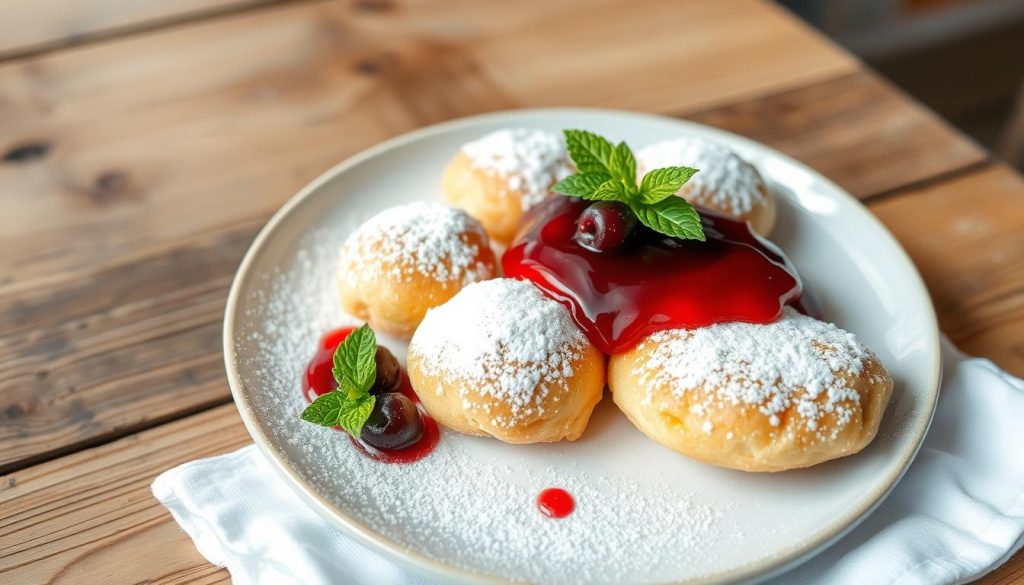
Pairing Austrian Dumplings with Traditional Dishes
Austrian cuisine is rich and diverse. Pairing Austrian dumplings with traditional dishes is an art. These side dishes can make any main course better, blending flavors perfectly.
Semmelknödel, the famous bread dumplings, pair well with Austrian cuisine favorites like Wiener Schnitzel or Tafelspitz (boiled beef). The dumplings’ light texture and neutral taste let the main dish stand out.
Spinatknödel (spinach dumplings) are great with stews and braises, like Gulasch (goulash) or Schweinebraten (roast pork). Their green color and savory taste match the bold flavors of these dishes.
Dessert dumplings, like Germknödel, are also a hit. These sweet dumplings, filled with plum jam or poppy seed butter, go well with vanilla sauce or powdered sugar. They’re a sweet treat at the end of a meal.
Whether you’re trying a classic knödel dish or exploring Austrian regional flavors, the secret is understanding textures, flavors, and traditions. Embracing these dumplings opens up a world of culinary joy that shows off Austrian food at its best.
Seasonal Dumpling Specialties in Austrian Cuisine
In Austria, dumplings get a special twist with the seasons. Chefs and home cooks celebrate each season with unique dumplings. From summer to winter, they create dishes that reflect the country’s rich food culture.
Summer Fruit Dumplings
Summer brings fresh produce to Austrian kitchens. The result is fruit knödel, a sweet treat. These dumplings are filled with plums, apricots, or wild berries in a soft dough.
They offer a perfect mix of sweet and tart. It’s a treat for your taste buds.
Hearty Winter Varieties
Winter brings snow to Austria, and so do heartier dumplings. These seasonal Austrian dumplings are made with ingredients like roasted chestnuts and Graukäse cheese. They’re perfect for warming up by the fire.
“The true essence of Austrian cuisine is captured in the transformation of our beloved dumplings through the seasons.”
Enjoying Austrian dumplings is a journey through the seasons. Whether it’s the sweet summer treats or the comforting winter dishes, they show Austria’s culinary skill. They also highlight the connection between food and nature’s cycles.
Modern Twists on Classic Austrian Dumplings
In the world of Austrian cuisine, chefs are making the modern knödel exciting again. They mix old ways with new flavors. This makes the traditional dumpling a hit with food lovers everywhere.
Chef Lukas Nagl is a great example. His Beef Cheek Knödel is famous at his Michelin-starred place in Vienna. He combines tender beef, spices, and soft semmelknödel. It’s a mix of old and new that people love.
“Dumplings are the heart of Austrian food, but they can change,” says Nagl. “It’s about keeping the tradition alive while exploring new tastes and textures.”
In Salzburg, Chef Marlene Gruber has made the Spinatknödel special. She adds herbs, goat cheese, and truffle oil. It’s a mix of old Tyrolean ways and new global tastes.
| Traditional Knödel | Modern Interpretation |
|---|---|
| Semmelknödel (Bread Dumpling) | Beef Cheek Knödel with Braised Beef and Spices |
| Spinatknödel (Spinach Dumpling) | Spinatknödel with Goat Cheese and Truffle Oil |
| Germknödel (Sweet Dumpling) | Germknödel with Roasted Apple and Cinnamon |
These new takes on contemporary Austrian cuisine and modern knödel are more than just updates. They celebrate Austria’s rich food history. They show off the creativity of Austria’s chefs. And they prove that dumplings are still loved today.
Storage and Reheating Tips for Homemade Dumplings
Making homemade Austrian dumplings is a labor of love. But it doesn’t stop after you make them. Storing and reheating them right is key to keeping their taste and texture. As someone who loves dumplings, I’m excited to share my top tips for keeping your knödel fresh. Whether it’s for a special event or enjoying leftovers, these tips will help.
Freezing Methods
Freezing is a great way to keep your dumplings fresh for longer. Here’s how to freeze them:
- Let the dumplings cool completely after cooking.
- Put them in a single layer on a baking sheet or plate, without touching.
- Freeze for 2-3 hours until they’re firm.
- Put the frozen dumplings in an airtight container or freezer-safe bag, squeezing out air.
- Freeze for up to 3 months, marking the container with the date.
Reviving Leftover Dumplings
When it’s time to enjoy your frozen dumpling storage, reheat them gently. This keeps their texture soft. Here’s how to reheat knödel perfectly:
- Thaw the dumplings in the fridge overnight before reheating.
- Steam them in a basket for 10-15 minutes, until warm.
- Or, simmer them in broth or water for 5-7 minutes.
- Don’t microwave dumplings, as it makes them rubbery.
With these easy tips, you can enjoy homemade Austrian dumplings long after they’re made. These methods let you store and reheat dumplings while keeping their authentic taste and texture.
Health Benefits and Nutritional Value
Austrian dumplings are more than just tasty side dishes. They offer a range of nutrients, making them a healthier choice than you might think.
The secret to their health benefits lies in the ingredients and how they’re made. Traditional Austrian dumplings use bread, potatoes, or spinach. These ingredients provide complex carbs, fiber, and important vitamins and minerals.
Semmelknödel, or bread dumplings, are packed with B vitamins and minerals like iron and magnesium. They’re made with whole-grain bread. Spinatknödel, the spinach dumplings from Tyrol, are rich in vitamins A, C, and K, plus folate.
| Dumpling Variety | Key Nutrients | Potential Health Benefits |
|---|---|---|
| Semmelknödel (Bread Dumplings) | B vitamins, iron, magnesium | Supports energy metabolism, healthy blood formation, and bone health |
| Spinatknödel (Spinach Dumplings) | Vitamins A, C, K, folate | Promotes eye health, immune function, and cell growth |
| Germknödel (Sweet Yeast Dumplings) | Complex carbohydrates, B vitamins | Provides sustained energy and supports nervous system function |
With a bit of creativity and choosing wholesome ingredients, healthy knödel can be a great part of a balanced diet. Knowing the nutritional values of different Austrian dumplings helps you make smart choices. This way, you can enjoy these tasty side dishes without sacrificing your health goals.
Common Challenges and Troubleshooting
Making authentic Austrian dumplings is a fun cooking adventure, but it comes with its own set of challenges. As someone who loves to cook at home, I’ve faced many issues. But I’ve also found ways to fix them, so your knödel dishes will always be perfect.
Getting the right texture is often a problem. If your dumplings are too dense or sticky, it might be because of the flour-to-liquid ratio. Start with a drier dough and add more liquid slowly. This will help you get a light and fluffy texture.
Dealing with flavor imbalances can be tricky too. If your dumplings taste too strong or not flavorful enough, it’s easy to fix. Just taste the dough before cooking and adjust the spices or herbs a bit. The goal is to let the natural flavors of the ingredients stand out.
